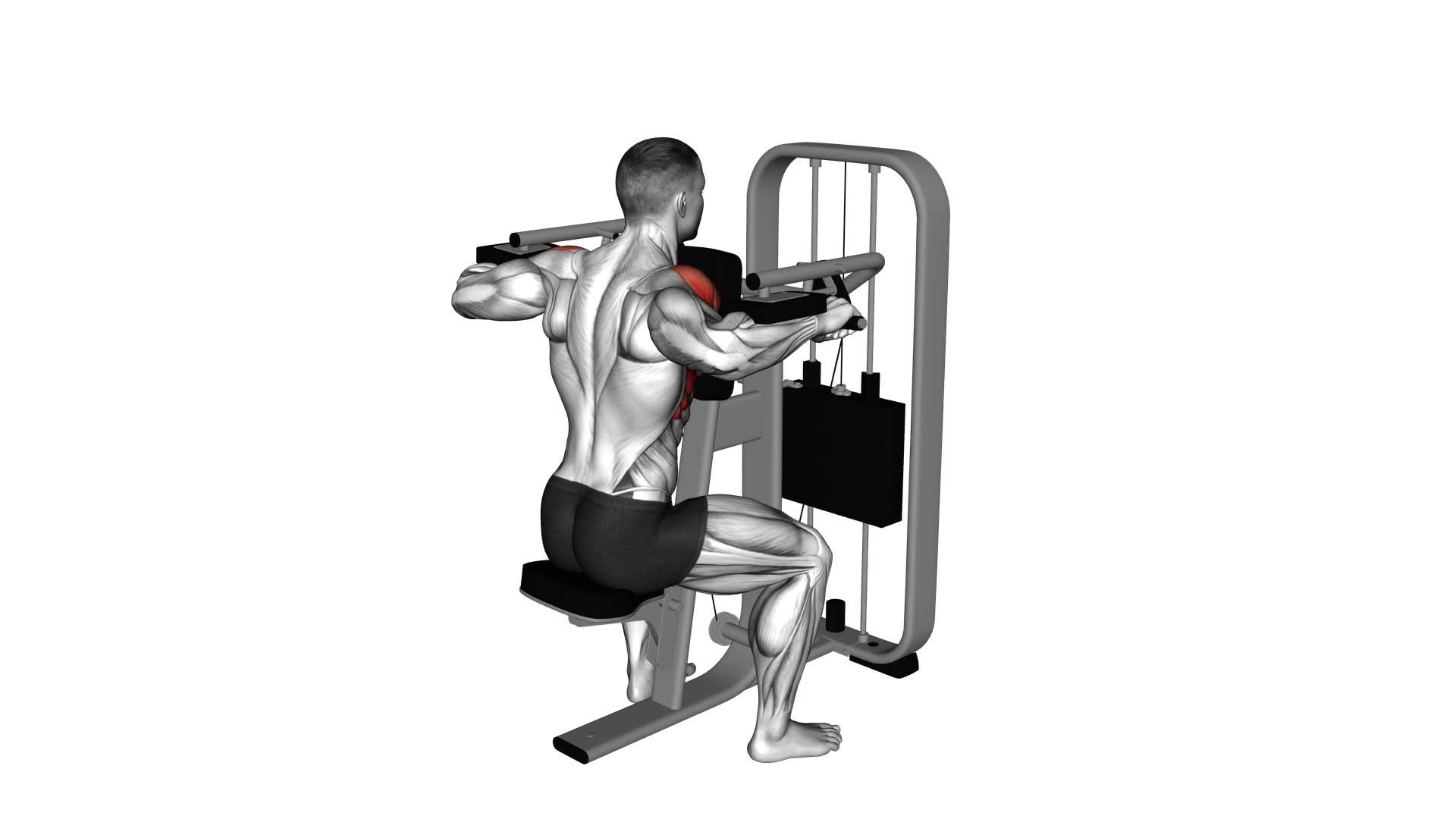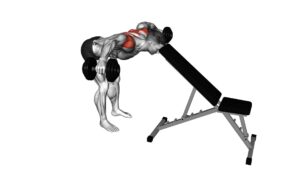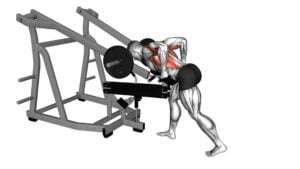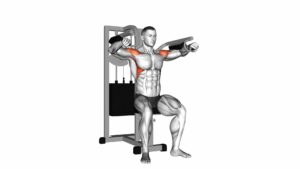Lever Lateral Raise With Chest Support (Male) – Video Exercise Guide & Tips

Looking to strengthen your shoulders and chest? Try the Lever Lateral Raise with Chest Support.
Watch This Exercise Video
This exercise guide provides step-by-step instructions, tips, and a video demonstration to help you perform the exercise correctly.
Learn about the benefits, equipment needed, and common mistakes to avoid.
Maximize the effectiveness of this exercise and discover alternative exercises to complement your routine.
Get ready to elevate your upper body workout with the Lever Lateral Raise with Chest Support.
Key Takeaways
- Lever Lateral Raise With Chest Support targets and strengthens the shoulder muscles.
- It provides additional support to the chest, reducing the risk of injury.
- The exercise isolates and focuses on the shoulder muscles, improving shoulder strength and stability.
- Alternatives to chest support include using a stability ball or a low incline bench, or modifying the lever lateral raise exercise.
Benefits of Lever Lateral Raise With Chest Support
The lever lateral raise with chest support offers several benefits for you. This exercise is a great way to target and strengthen your shoulder muscles while providing additional support to your chest. By using the lever machine and the chest support, you can isolate and focus on your shoulder muscles without straining other parts of your body.
One of the primary benefits of the lever lateral raise with chest support is that it helps to improve your shoulder strength. This exercise specifically targets the deltoid muscles, which are responsible for lifting and rotating your arms. By regularly performing this exercise, you can increase the strength and stability of your shoulders, making daily activities like reaching and lifting easier and more efficient.
Additionally, the chest support provided by the lever machine ensures that your upper body remains stable and supported throughout the exercise. This reduces the risk of injury and allows you to focus solely on engaging your shoulder muscles. The chest support also helps to prevent any excessive leaning or swinging, promoting proper form and maximizing the effectiveness of the exercise.
Equipment Needed for Lever Lateral Raise With Chest Support
To perform the Lever Lateral Raise with Chest Support, you'll need essential equipment such as a lever lateral raise machine and a chest support pad. The lever lateral raise machine allows you to target your lateral deltoids effectively while the chest support pad provides stability and support for your upper body during the exercise.
If you don't have access to a lever lateral raise machine, you can use dumbbells as an alternative to achieve a similar movement pattern.
Essential Equipment for Exercise
To perform the Lever Lateral Raise with Chest Support, you'll need a bench or adjustable seat. This exercise requires a sturdy and comfortable surface to support your chest while performing the lateral raises.
The bench or adjustable seat should be positioned in a way that allows your arms to move freely without any obstructions. Having the right equipment is essential for ensuring proper form and maximizing the benefits of this exercise.
By using a bench or adjustable seat, you can maintain stability and control throughout the movement, preventing any unnecessary strain on your lower back or shoulders. It also enables you to focus on isolating and targeting the lateral deltoid muscles effectively.
Alternatives to Chest Support
If you don't have access to a bench or adjustable seat for the Lever Lateral Raise with Chest Support, there are alternative equipment options you can use.
One option is to use a stability ball. Simply position yourself facing down on the ball with your chest resting on it and your feet on the ground for stability.
Alternatively, you can use a low incline bench or even a step platform. Ensure that your chest is supported and secure before performing the exercise.
These chest support alternatives will allow you to perform a modified lever lateral raise while still targeting the lateral deltoids effectively.
Now that you know the alternatives, let's move on to the step-by-step guide to performing the lever lateral raise with chest support.
Step-By-Step Guide to Performing Lever Lateral Raise With Chest Support
To perform the Lever Lateral Raise With Chest Support correctly, it's important to focus on proper form techniques.
This exercise targets the lateral deltoids and helps improve shoulder stability.
Avoid common mistakes such as using momentum or lifting too heavy, and instead, maintain control throughout the movement for maximum effectiveness.
Proper Form Techniques
Perform the Lever Lateral Raise With Chest Support exercise by following these step-by-step instructions:
- Sit on the lever lateral raise machine with your chest against the support pad.
- Adjust the lever arm so that the handles are at shoulder level.
- Grasp the handles with an overhand grip and keep your arms slightly bent.
- Lift the handles out to the sides while maintaining a slight bend in your elbows.
- Raise your arms until they're parallel to the floor, then slowly lower them back down.
By following these proper form techniques, you'll effectively target your lateral deltoid muscles. Remember to engage your core and maintain a controlled and steady motion throughout the exercise.
Now that you know the correct form, let's move on to the next section to learn about common mistakes to avoid during the Lever Lateral Raise With Chest Support exercise.
Common Mistakes to Avoid
To avoid common mistakes while performing the Lever Lateral Raise With Chest Support exercise, focus on maintaining proper form and control throughout the movement. This will help you avoid injury and maximize the effectiveness of the exercise.
One common mistake to avoid is using too much weight, as this can compromise your form and increase the risk of injury. It's important to start with a weight that you can comfortably lift and gradually increase it as you become stronger.
Another mistake to avoid is allowing your body to sway or twist during the movement. This can put unnecessary strain on your lower back and decrease the effectiveness of the exercise. To maintain proper alignment, keep your chest pressed against the support pad and your core engaged throughout the movement.
Common Mistakes to Avoid During Lever Lateral Raise With Chest Support
When performing the Lever Lateral Raise With Chest Support, it's crucial to avoid these common mistakes:
- Using too much weight: It's important to start with a weight that allows you to maintain proper form throughout the exercise. Using too much weight can lead to poor technique and potential injuries.
- Swinging the body: Avoid using momentum to lift the weight. Keep your body stable and focus on using your shoulders to perform the movement.
- Lifting the arms too high: While it's tempting to lift your arms as high as possible, it's important to only raise them to shoulder height. Lifting too high can strain your shoulders and compromise your form.
- Leaning forward or backward: Maintain an upright posture throughout the exercise. Leaning forward or backward can put unnecessary stress on your lower back and negate the targeted benefits of the exercise.
- Neglecting the mind-muscle connection: Stay focused on your shoulder muscles throughout the exercise. Concentrate on contracting and engaging your shoulders to ensure you're getting the most out of the exercise.
Tips to Maximize the Effectiveness of Lever Lateral Raise With Chest Support
To maximize the effectiveness of the Lever Lateral Raise With Chest Support, you should focus on maintaining proper form and engaging your shoulder muscles throughout the exercise. By following these tips, you can maximize your shoulder gains and get the most out of this exercise.
First and foremost, it's crucial to maintain proper form throughout the movement. Keep your back straight and your chest supported against the pad. This will ensure that the exercise targets your shoulder muscles effectively.
Engaging your shoulder muscles is key to maximizing the effectiveness of this exercise. As you raise the lever, focus on using your shoulder muscles to lift the weight, rather than relying on momentum or other muscle groups. This will ensure that your shoulders are doing the majority of the work, leading to better results.
For advanced lifters looking to further challenge themselves, there are variations you can incorporate into the Lever Lateral Raise With Chest Support. One option is to increase the weight you're lifting, gradually progressing as your strength improves. Another option is to slow down the movement, focusing on controlled and deliberate lifts to increase the time under tension for your shoulder muscles.
Alternative Exercises to Complement Lever Lateral Raise With Chest Support
To complement the Lever Lateral Raise With Chest Support, you can try incorporating alternative exercises that target the shoulders and provide a well-rounded workout. Here are some variations of lateral raises and their benefits:
- Dumbbell Lateral Raises: Grab a pair of dumbbells and stand with your feet hip-width apart. With a slight bend in your elbows, raise your arms out to the sides until they're parallel to the floor. This exercise helps to strengthen the deltoids and improve shoulder stability.
- Cable Lateral Raises: Attach a D-handle to a cable machine at waist height. Stand with your side facing the machine and grab the handle with your hand. Keeping your arm straight, lift it out to the side until it's parallel to the floor. This exercise provides constant tension on the shoulders and engages the stabilizing muscles.
- Front Raises: Hold a dumbbell in each hand and stand with your feet shoulder-width apart. With a slight bend in your elbows, raise the dumbbells in front of you until they're at shoulder height. This exercise targets the front and middle deltoids, helping to improve shoulder strength and stability.
- Bent-Over Lateral Raises: Bend forward at the hips, keeping your back straight and core engaged. Hold a dumbbell in each hand and let your arms hang down perpendicular to the floor. With a slight bend in your elbows, raise your arms out to the sides until they're parallel to the floor. This exercise targets the rear deltoids and helps to improve posture.
- Arnold Press: Sit on a bench with a dumbbell in each hand, palms facing your body. Start with your arms bent and palms facing your shoulders. Press the dumbbells overhead while rotating your palms to face forward. This exercise targets all three heads of the deltoids and helps to develop overall shoulder strength.
Incorporating these alternative exercises into your routine won't only provide variety but also help you achieve a well-rounded shoulder workout.
Frequently Asked Questions
How Many Sets and Reps Should I Do for Lever Lateral Raise With Chest Support?
To determine the ideal sets and reps for the lever lateral raise with chest support, consider your fitness goals and current ability level. This exercise targets the shoulders and helps improve strength and stability.
Start with 2-3 sets of 8-12 reps, focusing on maintaining proper form throughout.
If you're looking for alternative exercises, you can try dumbbell lateral raises or cable lateral raises.
Can Lever Lateral Raise With Chest Support Help in Building Chest Muscles?
Lever lateral raise with chest support can indeed help in building chest muscles. By incorporating this exercise into your routine, you can target and strengthen the muscles in your chest region.
The lever lateral raise benefits include improved chest muscle definition and increased upper body strength. To perform this exercise correctly, focus on maintaining proper form and technique.
Is Lever Lateral Raise With Chest Support Suitable for Beginners?
Yes, lever lateral raise with chest support is suitable for beginners.
It's a great exercise for targeting your shoulder muscles and improving overall upper body strength.
To ensure proper form, keep your back straight and chest supported throughout the movement.
Avoid swinging or using momentum to lift the weight, as this can lead to injury.
Start with lighter weights and gradually increase as you become more comfortable with the exercise.
Can Lever Lateral Raise With Chest Support Help in Improving Posture?
Lever lateral raise with chest support can definitely help improve your posture. By targeting the shoulders and upper back, this exercise can strengthen the muscles responsible for maintaining proper alignment.
Not only does it promote shoulder stability, but it also enhances overall upper body strength. Incorporating lever lateral raise with chest support into your full body workout routine can be beneficial for developing balanced muscle strength and preventing postural imbalances.
What Are Some Variations of Lever Lateral Raise With Chest Support That I Can Try?
There are several variations of the lever lateral raise with chest support that you can try.
Different ways to modify this exercise include using different hand positions, adjusting the weight resistance, and changing the range of motion.
These variations can help target different muscles in your shoulders and upper back, allowing for a more well-rounded workout.
Don't be afraid to experiment and find the variations that work best for you.
Conclusion
In conclusion, the lever lateral raise with chest support is an effective exercise for targeting the lateral deltoids. By providing stability and support, this exercise allows for better isolation of the targeted muscles.
It's important to use proper form and avoid common mistakes to maximize the effectiveness of this exercise. Additionally, there are alternative exercises that can be incorporated to further enhance the benefits of the lever lateral raise with chest support.

Author
Years ago, the spark of my life’s passion ignited in my mind the moment I stepped into the local gym for the first time. The inaugural bead of perspiration, the initial endeavor, the very first surge of endorphins, and a sense of pride that washed over me post-workout marked the beginning of my deep-seated interest in strength sports, fitness, and sports nutrition. This very curiosity blossomed rapidly into a profound fascination, propelling me to earn a Master’s degree in Physical Education from the Academy of Physical Education in Krakow, followed by a Sports Manager diploma from the Jagiellonian University. My journey of growth led me to gain more specialized qualifications, such as being a certified personal trainer with a focus on sports dietetics, a lifeguard, and an instructor for wellness and corrective gymnastics. Theoretical knowledge paired seamlessly with practical experience, reinforcing my belief that the transformation of individuals under my guidance was also a reflection of my personal growth. This belief holds true even today. Each day, I strive to push the boundaries and explore new realms. These realms gently elevate me to greater heights. The unique combination of passion for my field and the continuous quest for growth fuels my drive to break new ground.







